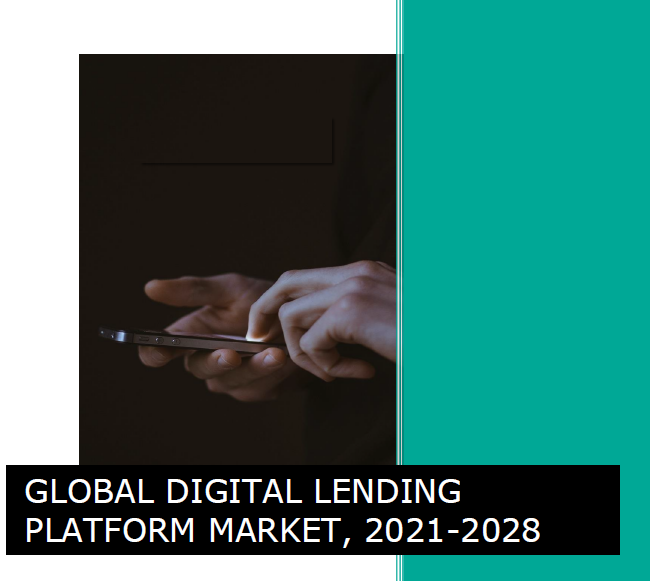Introducing Single Price Syndicate Report

GLOBAL DIGITAL LENDING PLATFORM MARKET
MARKET ANALYSIS & SEGMENT FORECAST FROM 2021 TO 2028Global Digital Lending Platform Market Size, Share & Trends Analysis Report By Product (Personal Loan, SME Finance Loan, Automotive Loan, and Mortgage Loan), By Deployment mode (On-premises and Cloud-based), By Solutions (Business Process Management, Loan Origination System, Loan Management Software, Risk & Compliance Management, Lending Analytics, Collection & Recovery System, and other solutions), By Application (Banking, Financial Services, Insurance, Credit Unions, Retail Banking, and Peer to Peer (P2P) Lender), By Region (North America, Europe, Asia-Pacific, South America, and ME&A) And Segment Forecasts, 2021 - 2028
Published Date: TBD
Base Year for Estimate: 2020
Report ID: KYMGLIT04
Format: Electronic (PDF)
Number of Pages: TBD
Price: USD 5000
Market Outlook
Market Size & Forecast (2021-2028)
Segment Analysis (2021-2028)
Market Drivers & Restraints
COVID-19 Impact Analysis
Competitive Landscape & Company Profiles
KOL Commentary (Primary Research)
Session With Analyst
The practice of offering loans that are applied for, issued, and maintained using a digital platform is known as digital lending. Borrowers and lenders can utilize a digital lending platform to lend money using paperless or electronic means, which provides simplicity of use, a better customer experience, and lower costs by reducing client verification time.
The online lending process starts with user registration, followed by online paperwork submission, client identification and verification, loan approval, loan pay-out, and loan recovery. This software is becoming more popular among banks as it provides smooth monitoring and increased profitability.
Furthermore, it makes it simple for borrowers to apply for loans and provides them with transparency, resulting in considerable time savings. This automated aspect of the online lending platform allows lenders and borrowers to supply financing solutions with greater precision, decreasing stress and improving the likelihood of successful loan approval.
Market Growth Factors:
- The increasing efficiency of the digital lending platform: The use of technological advancements such as e-signature, biometric identification, and cloud channels to store electronic files has made the online lending process faster, easier, and less expensive, increasing the efficiency of the digital lending platform and increasing consumer trust, resulting in new market growth potential.
- The changing customer requirements: Consumer expectations and behavior are changing because of the numerous benefits provided by the digitalization of banking and financial services. Customers come from many walks of life and may need the loan for several reasons, including personal loans, SME financing, and house loans, among others.
- Increasing adoption of internet services: The growing use of internet services and digital platforms by banks, financial firms, fintech, and other electronic lenders to improve the borrower experience is fueling the digital lending platform industry growth.
- Growth of prospective lending customers through internet behavior: With only a few years of job experience and no credit history, youngsters discover that their loans are either denied or come with hefty interest rates.
Furthermore, the average time to decide for a small company and corporate loans in traditional banks is three to five weeks, with an average wait to cash of nearly three months. Customers who use mobile devices to access digital lending apps are responding to these difficulties by adopting a digital habit.
Market Drivers and restraints:
Drivers:
- The emergence of advanced technologies: The acceptance of many technical developments, such as the widespread use of smartphones, has resulted in a rise in digital banking acceptance across a variety of end-user sectors. Artificial intelligence, machine learning, and cloud computing are also beneficial to banks and fintech because they can analyze large volumes of data on clients. This information and data are then compared to produce findings regarding appropriate services/solutions that clients desire, therefore assisting in the development of customer relationships.
- Growth in cloud-based digital lending technologies: For growing up their operations, speed, and flexibility in responding to changing customer demands, digital lenders have adopted cloud technology. Costs of data storage have decreased because of cloud-based infrastructure. This has made managing big data and using complex analytics simpler, as well as lowering the entrance hurdles for new FinTech innovators.
- Government initiatives to digital lending: Digital lending will be encouraged and enabled through advances in data storage and computing, as well as government support for financing infrastructure development. Government and regulatory agencies have an important role in developing, implementing, and monitoring comprehensive policies that benefit consumers, companies, and investors. The government's initiative measures include giving FinTech lenders incentives for increasing the quantity and affordability of credit goods and services, as well as boosting demand for credit through financially empowering and educating consumers.
- Adoption of digitalization: Due to the increasing acceptance of digitalization in the BFSI business, the lending environment has evolved dramatically. In many regions of the world, conventional lending is still practiced. The advantages given by digital software solutions, on the other hand, are rapidly paving the way for business adoption of digital lending solutions and services.
Restraints:
- Security-related issues: While digital lending usage is rising across the sector for various business areas within the lending business, lenders' concerns about data moving out of their control have kept them from fully adopting the technology. In the sector, a completely new viewpoint on security is also being explored. To create a safer environment, lenders must consider not only the technology but also the bigger picture: the complete ecosystem of data and apps that will be used.
- Digital illiteracy in underdeveloped countries: Many nations are unfamiliar with digital technology, which might impede the widespread adoption of digital lending solutions. Due to limited digital transactions, technology providers are likewise unwilling to invest in the region. As a result, the flat digital literacy rate in developing nations is projected to stifle the market for digital lending platforms.
Market Developments:
- Rising internet penetration and widespread availability of digital gadgets: The expanding usage of the digital lending platform to get loans is aided by rising internet penetration and the widespread availability of smartphones throughout the world. Digitization is being aided by the widespread availability of these gadgets. This allows financial institutions to reach a larger audience and promote their loan products via brief advertising or notice on smartphones and tablets.
- The advent of Artificial Intelligence and blockchain technology: The advent of sophisticated technologies such as AI and blockchain, which help market participants in innovating new operating models to give loans to a variety of individuals and organizations, is driving the rising demand for the digital lending platform. The data-driven AI digital lending platform is anticipated to reduce the time it takes to get a loan online. The demand for actionable information to decrease operating costs, detect possible defaulters, increase client engagement, and make better decisions is pushing the adoption of AI technology in the digital lending platform.
Region-wise developments:
Increasing worldwide digitalization is assisting digital lending platform providers in promoting their financial lending solutions across multiple digital platforms. The market's growth is being aided by growing internet penetration in the United States and Europe regions. Southeast Asia and India are well-positioned for more investments and growth in the digital lending area, as they have a large and relevant population for digital credit facilities, as well as the proper socio-economic variables, such as rising internet penetration and dedicated government initiatives.
The report covers the following major segments of the Digital lending platforms market:
- By Product: Personal Loan, SME Finance Loan, Automotive Loan, and Mortgage Loan
- By Deployment mode: On-premises and Cloud-based
- By Solutions: Business Process Management, Loan Origination System, Loan Management Software, Risk & Compliance Management, Lending Analytics, Collection & Recovery System, and other solutions
- By Application: Banking, Financial Services, Insurance, Credit Unions, Retail Banking, and Peer to Peer (P2P) Lender
- By Region: North America, Europe, Asia-Pacific, South America, and ME&A
Report Related Frequently Asked Questions?
Buy full detailed market research report to get full insights!
